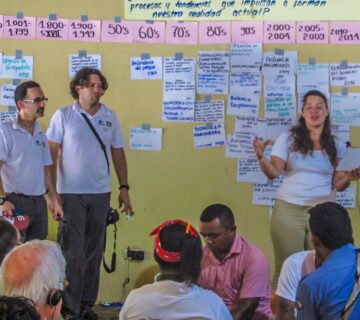The Architecture Team hosted one of IE’s online Thematic tables in April and pitched this question to the broad field of experts that make up IE’s membership.
About 30 members took part and to warm up an unseasonably chilly April day we exchanged our home interiors for an open space in Pompeii as the zoom meeting background. We kicked off with a couple of short presentations, then divided into breakout groups to discuss the question and ended with summaries from each group. The event was moderated by David Masters of Imagemakers (UK). Niall Phillips of Purcell Architects (UK) kindly joined us as guest speaker, presenting the planning for the museum of flight, Aerospace Bristol, as an example of good collaborative planning. This was followed by an example full of missed opportunities presented by Angus Forbes.
It was fascinating to hear participants’ professional experiences and informed viewpoints on this subject. Fitting together the pieces of the puzzle afterwards provides the following picture.
Ideally, interpretation is already considered in the procurement stage and has been stipulated in the funding programme if there is one. The consultants charged with writing the brief or competition document for the architects and designers have included it in their requirements.
In smaller projects, the interpretive input is in the hands of the architect or designer, so it is essential that they understand and are enthusiastic about the opportunities provided by heritage interpretation. Heritage projects form only a fraction of commissions given to architecture offices. For most of them, interpretive planning will be an approach they can learn about and occasionally apply rather than a specialisation.
The client might have commissioned an interpretive planner to establish the main narratives in advance, perhaps in the form of an interpretive masterplan. Public clients, recognising heritage interpretation’s potential as a motor for community development, social integration and reconciliation, will choose to run an interpretive form of public participation. If the budget allows for it, an interpretive planner will sit alongside architects, designers and engineers in a design team. If the design team is truly collaborative, ideas are worked on together and creative synergies enable the whole to be more than the sum of its parts.
If it isn’t, wasted money, poor design, inappropriate solutions and lost opportunities result. Examples of poor collaborative planning may put clients off taking this approach. Both the client and the architect may also feel threatened in their authority by an additional planner keen to influence the central premises of the project. Interpretive planning may be seen as adding extra expense, work and complications to a project both during the planning process and later, when there is no more funding available for follow-up.
An interpretive masterplan can however hold things together and facilitate decisions by providing clear narrative threads for the project.
In conclusion, there seems to be no consensus yet on the best way to integrate heritage interpretation into planning projects. One thing for sure is that Interpret Europe needs to think hard about how to reach out to funding directors, clients, brief writing consultants, architects and designers and to convince them of the advantages of incorporating heritage interpretation into their planning process.
Angus Forbes is IE’s Architects Coordinator and moderates the Interpret Europe Architecture Group on Facebook. Originally from Scotland, UK, he now lives and works in Germany as a landscape architect. He can be contacted at: angus.forbes@interpret-europe.net.
To cite this article: Forbes, Angus (2021) ‘How is interpretive planning best integrated into collaborative projects?’ in Interpret Europe Newsletter 2-2021, 9.
Available online: https://interpret-europe.net/wp-content/uploads/2021/06/Newsletter-Summer-2021.pdf




